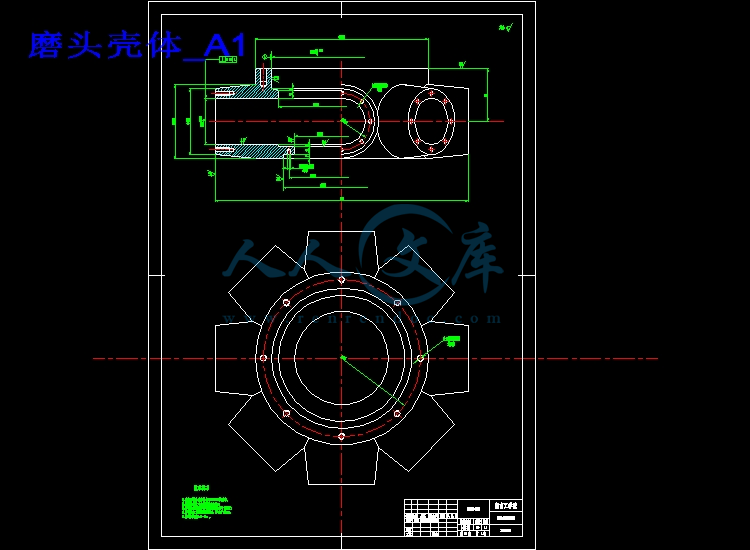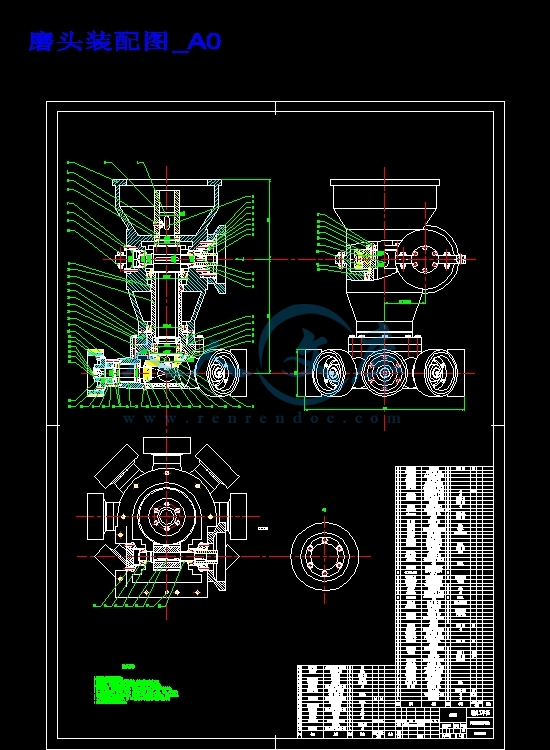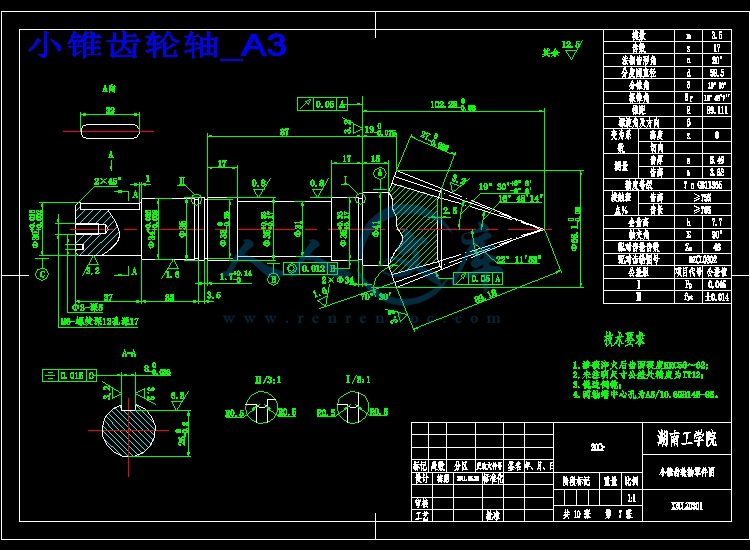!【详情如下】CAD图纸+word设计说明书.doc[20000字,65页]【需要咨询购买全套设计请加QQ97666224】.bat
中期检查表.doc
任务书.doc
外文翻译
开题报告.doc
大锥齿轮_A3.dwg
小锥齿轮轴_A3.dwg
电动机联接盖_A2.dwg
磨头壳体_A1.dwg
磨头箱体套环_A2.dwg
磨头装配图_A0.dwg
蜗杆轴_A3.dwg
蜗杆齿圈_A3.dwg
蜗轮轴_A1.dwg
蜗轮部件装配图_A1.dwg
摘 要
旋风磨头是用于粗磨机对瓷砖进行加工的执行部件,是比较新式的磨头,该磨头是采用八组高速旋转的金刚石砂轮对瓷质砖表面进行刚性磨削,对抛光砖进行粗加工,使砖面平整细滑,减小粗抛磨块的消耗量,降低生产成本,提高了生产效率。
本设计主要是对于旋风磨头的磨轮高速自转和磨头慢速公转进行结构设计和计算。由于两个传动的转速差较大采用两个电机分别进行驱动。磨轮的自转设计为大锥齿轮啮合八个小锥齿轮进行转动,用于实现金刚磨轮的高速自转,磨头的公转采用蜗轮蜗杆传动设计用来实现磨头的公转,并且分别对锥齿轮和蜗轮蜗杆进行了强度校核。本设计还对磨头中各轴、轴承和键进行了强度校核。使用CAD绘制完二维视图后还采用PRO/E建模对箱体壳体进行重量计算。
关键词:陶瓷抛光,旋风磨头,锥齿轮,蜗轮蜗杆
ABSTRACT
A whirling wheelhead on a rasping machine is an executive unit that is used to process the ceramic tile, and it is a new type. The wheelhead uses eight groups high- speed whirling diamond grinding wheel to grind the surface of porcelain brick., and process minimally to the polishing brick in order to make the surface even and lubricious, then it can minish the comsuption of unprocessed brcik, reduce the production cost and improve productivity and efficiency.
This design is mainly on contruction designming and calculation of the high-speed rotation of grinding wheel and slow-speed revolution of wheelhead. Because of the difference of rotate speed of the two drives, so it has to use two electric machine to drive. The rotation of grinding wheel is degined into a big bevel gear running with eight samll bevel gear in mesh, so as to realize the high-speed rotation of diamond grinding wheel. Worm wheel and worm transmission designment is used to realize the revolution of it. And this design checks the strength of gear and the worm wheel, axis, bearing and bond separately. Two-dimensional view is drawn by CAD, and the weight calculation of the cabinet and shell is done by PRO/E medeling.
Keywords: Polish ceramic tile;whirling wheelhead;bevel gear;worm and worm wheel
目 录
1 绪论1
2 磨头传动装置的总体设计2
2.1 确定传动方案2
2.1.2 方案一2
2.1.1 方案二3
2.1.3 磨头传动方案的选定3
2.2 电动机的确定4
2.2.1 电动机类型和结构形式4
2.2.2 电动机的容量4
2.2.3 确定电动机的转速5
2.3 总传动比的确定和各级传动比的分配5
2.4 磨头的运动和动力参数的计算6
2.4.1 各轴转速的计算6
2.4.2 各轴功率的计算7
2.4.3 各轴转矩的计算7
3 磨头传动件的设计计算9
3.1 选则联轴器的类型和型号9
3.2 磨轮自转的直齿圆锥齿轮的设计计算9
3.2.1 齿轮材料的选则9
3.2.2 主要参数的选则9
3.2.3 直齿圆锥齿轮的几个尺寸设计和强度校核10
3.3 磨头公转的蜗轮蜗杆传动计算15
3.3.1传动类型、精度等级和材料的确定15
3.3.2 初选几何参数15
3.3.3 确定许用接触应力15
3.3.4 按接触强度设计15
3.3.5 主要几何尺寸16
3.3.6 蜗轮圆周速度的计算并核对传动的效率16
3.3.7接触强度的校核16
3.3.8 蜗轮弯曲强度的校核17
3.3.9 其他几何尺寸计算17
4 磨头轴系的设计19
4.1 初绘装配底图及验算轴系零件19
4.1.1 确定箱内传动件轮廓及其相对位置19
4.1.2 箱体内壁位置的确定20
4.1.3 初步进行视图布置及绘制装配底图20
4.1.4 磨头公转蜗杆轴的设计21
4.1.5 磨轮自转的直齿圆锥主动齿的轮轴的设计26
4.1.6 磨轮公转蜗轮轴的设计30
4.1.7 磨轮自转小锥齿轮轴的设计34
4.1.8 旋风磨头上各轴键联接的强度校核38
4.1.9 旋风磨头上各轴承的疲劳强度校核40
4.1.10 磨头主要部件螺栓联接强度的校核45
4.1.11 轴结构的修改45
4.2 设计和绘制磨头的轴系结构45
4.2.1 锥齿轮和蜗轮蜗杆的结构设计45
5 磨头箱体的设计48
5.1 磨头箱体的结构设计48
5.1.1 磨头箱体的装配48
5.1.2 磨头壳体的尺寸确定51
5.1.3 箱体的润滑及密封和散热52
结 论55
参考文献57
致 谢58
附 录











 川公网安备: 51019002004831号
川公网安备: 51019002004831号